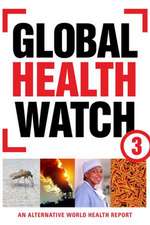Neighbourhood Structure and Health Promotion
Editat de Christiane Stock, Anne Ellawayen Limba Engleză Paperback – 20 mai 2015
Neighbourhood Structure and Health Promotion offers sociology-based theory and evidence-based findings so readers may better understand the effects of place on health choices, behaviour, and outcomes. This international volume analyzes the complex relationships among neighbourhood conditions and characteristics, people's perceptions of where they live, and their everyday health lives, from eating habits and activity levels to smoking, drinking, and drug use. Chapters introduce innovative methods for measuring and monitoring links between place and health in terms of risks and resources, and employing objective and subjective data. Prospects for engaging neighbourhoods in prevention efforts, particularly involving young people, and policy implications for the future of health promotion and inequity reduction are discussed as well. Included in the coverage:
- The spatiality of injustice: area effects on behaviour.
- Qualitative and quantitative methods for assessing neighbourhood health resources.
- The potential of GIS and GPS in the health sciences.
- Green spaces and health: possibilities for research and policy.
- School neighbourhoods and obesity prevention in youth.
- Connecting gender, social environment, and health.
| Toate formatele și edițiile | Preț | Express |
|---|---|---|
| Paperback (1) | 1080.09 lei 43-57 zile | |
| Springer Us – 20 mai 2015 | 1080.09 lei 43-57 zile | |
| Hardback (1) | 1087.12 lei 43-57 zile | |
| Springer Us – 5 apr 2013 | 1087.12 lei 43-57 zile |
Preț: 1080.09 lei
Preț vechi: 1136.94 lei
-5% Nou
Puncte Express: 1620
Preț estimativ în valută:
206.77€ • 212.65$ • 171.54£
206.77€ • 212.65$ • 171.54£
Carte tipărită la comandă
Livrare economică 17 februarie-03 martie
Preluare comenzi: 021 569.72.76
Specificații
ISBN-13: 9781489997548
ISBN-10: 1489997547
Pagini: 376
Ilustrații: VIII, 367 p.
Dimensiuni: 155 x 235 x 20 mm
Greutate: 0.53 kg
Ediția:2013
Editura: Springer Us
Colecția Springer
Locul publicării:New York, NY, United States
ISBN-10: 1489997547
Pagini: 376
Ilustrații: VIII, 367 p.
Dimensiuni: 155 x 235 x 20 mm
Greutate: 0.53 kg
Ediția:2013
Editura: Springer Us
Colecția Springer
Locul publicării:New York, NY, United States
Public țintă
ResearchDescriere
It has long been theorized that people living in poor areas have more health problems than their more advantaged peers. More recently, science has been testing this hypothesis, concentrating on the impact of the built environment on well-being and its contribution to health inequities.
Neighbourhood Structure and Health Promotion offers sociology-based theory and evidence-based findings so readers may better understand the effects of place on health choices, behaviour, and outcomes. This international volume analyzes the complex relationships among neighbourhood conditions and characteristics, people's perceptions of where they live, and their everyday health lives, from eating habits and activity levels to smoking, drinking, and drug use. Chapters introduce innovative methods for measuring and monitoring links between place and health in terms of risks and resources, and employing objective and subjective data. Prospects for engaging neighbourhoods in prevention efforts, particularly involving young people, and policy implications for the future of health promotion and inequity reduction are discussed as well. Included in the coverage:
Neighbourhood Structure and Health Promotion offers sociology-based theory and evidence-based findings so readers may better understand the effects of place on health choices, behaviour, and outcomes. This international volume analyzes the complex relationships among neighbourhood conditions and characteristics, people's perceptions of where they live, and their everyday health lives, from eating habits and activity levels to smoking, drinking, and drug use. Chapters introduce innovative methods for measuring and monitoring links between place and health in terms of risks and resources, and employing objective and subjective data. Prospects for engaging neighbourhoods in prevention efforts, particularly involving young people, and policy implications for the future of health promotion and inequity reduction are discussed as well. Included in the coverage:
- The spatiality of injustice: area effects on behaviour.
- Qualitative and quantitative methods for assessing neighbourhood health resources.
- The potential of GIS and GPS in the health sciences.
- Green spaces and health: possibilities for research and policy.
- School neighbourhoods and obesity prevention in youth.
- Connecting gender, social environment, and health.
Cuprins
1. Neighbourhood structure and health promotion: An introduction.- Part 1: Understanding health as a matter of place.- 2. Neighbourhood context and mortality: An overview.- 3. Area effects on behaviour and lifestyle: The spatiality of injustice.- 4. Sociological perspectives on neighbourhood context and health.- 5. People and place: The interrelated connections between interactions, behaviour, relations, perceptions and space.- Part 2: Measuring and monitoring neighbourhood structure.- 6. Methods to measure neighbourhoods and analyse their impact on health: An overview.- 7. Access to health promoting facilities and amenities.- 8. GIS: A spatial turn in the health science?.- 9. Using GPS to measure the interaction between individuals and their neighbourhood.- 10. Mathematical approaches to analyzing area level effects on health.- Part 3: Neighbourhood and lifestyle.- 11. Vitamin G - Green spaces and health: Potential mechanisms and policy implications, and ideas for further research.- 12. Socio-economic differences in physical activity: The role of neighbourhood factors.- 13. Building in prevention: Nudging towards physical activity and public health.- 14 .Rethinking exposure in area studies on social inequities in smoking in youth and young adults.- 15. Neighbourhood structure and alcohol and other drug use: Implications for prevention.- 16. Neighbourhoods and healthy nutrition.- 17. School neighbourhoods and obesity prevention in youth.- 18. Connecting gender, space and place: Are there gender differences in the relationships between the social environment and health-related behaviours?.- 19. From neighbourhood and health research to health promotion practice.
Recenzii
From the reviews:
“Neighbourhood Structure and Health Promotion examines some of the cutting-edge research focusing on why health and place matters, how it is measured, and how lifestyle behaviors interact with place. … I would use this book in a graduate-level seminar on health and place. … This book provides an excellent starting point for understanding the current state of the science and how place affects our health.” (Jay Maddock, PsycCRITIQUES, Vol. 58 (39), 2013)
“Neighbourhood Structure and Health Promotion examines some of the cutting-edge research focusing on why health and place matters, how it is measured, and how lifestyle behaviors interact with place. … I would use this book in a graduate-level seminar on health and place. … This book provides an excellent starting point for understanding the current state of the science and how place affects our health.” (Jay Maddock, PsycCRITIQUES, Vol. 58 (39), 2013)
Textul de pe ultima copertă
It has long been theorized that people living in poor areas have more health problems than their more advantaged peers. More recently, science has been testing this hypothesis, concentrating on the impact of the built environment on well-being and its contribution to health inequities.
Neighbourhood Structure and Health Promotion offers sociology-based theory and evidence-based findings so readers may better understand the effects of place on health choices, behaviour, and outcomes. This international volume analyzes the complex relationships among neighbourhood conditions and characteristics, people's perceptions of where they live, and their everyday health lives, from eating habits and activity levels to smoking, drinking, and drug use. Chapters introduce innovative methods for measuring and monitoring links between place and health in terms of risks and resources, and employing objective and subjective data. Prospects for engaging neighbourhoods in prevention efforts, particularly involving young people, and policy implications for the future of health promotion and inequity reduction are discussed as well. Included in the coverage:
Neighbourhood Structure and Health Promotion offers sociology-based theory and evidence-based findings so readers may better understand the effects of place on health choices, behaviour, and outcomes. This international volume analyzes the complex relationships among neighbourhood conditions and characteristics, people's perceptions of where they live, and their everyday health lives, from eating habits and activity levels to smoking, drinking, and drug use. Chapters introduce innovative methods for measuring and monitoring links between place and health in terms of risks and resources, and employing objective and subjective data. Prospects for engaging neighbourhoods in prevention efforts, particularly involving young people, and policy implications for the future of health promotion and inequity reduction are discussed as well. Included in the coverage:
- The spatiality of injustice: area effects on behaviour.
- Qualitative and quantitative methods for assessing neighbourhood health resources.
- The potential of GIS and GPS in the health sciences.
- Green spaces and health: possibilities for research and policy.
- School neighbourhoods and obesity prevention in youth.
- Connecting gender, social environment, and health.
Caracteristici
The only book on neigbourhood structure and health focusing on health behavior and lifestyle: physical activity, smoking
Provides examples from Europe in this area of research
Provides information on new and innovative methods and techniques to study and analyze neighborhood structure, including GIS, multilevel modeling
Provides examples from Europe in this area of research
Provides information on new and innovative methods and techniques to study and analyze neighborhood structure, including GIS, multilevel modeling












